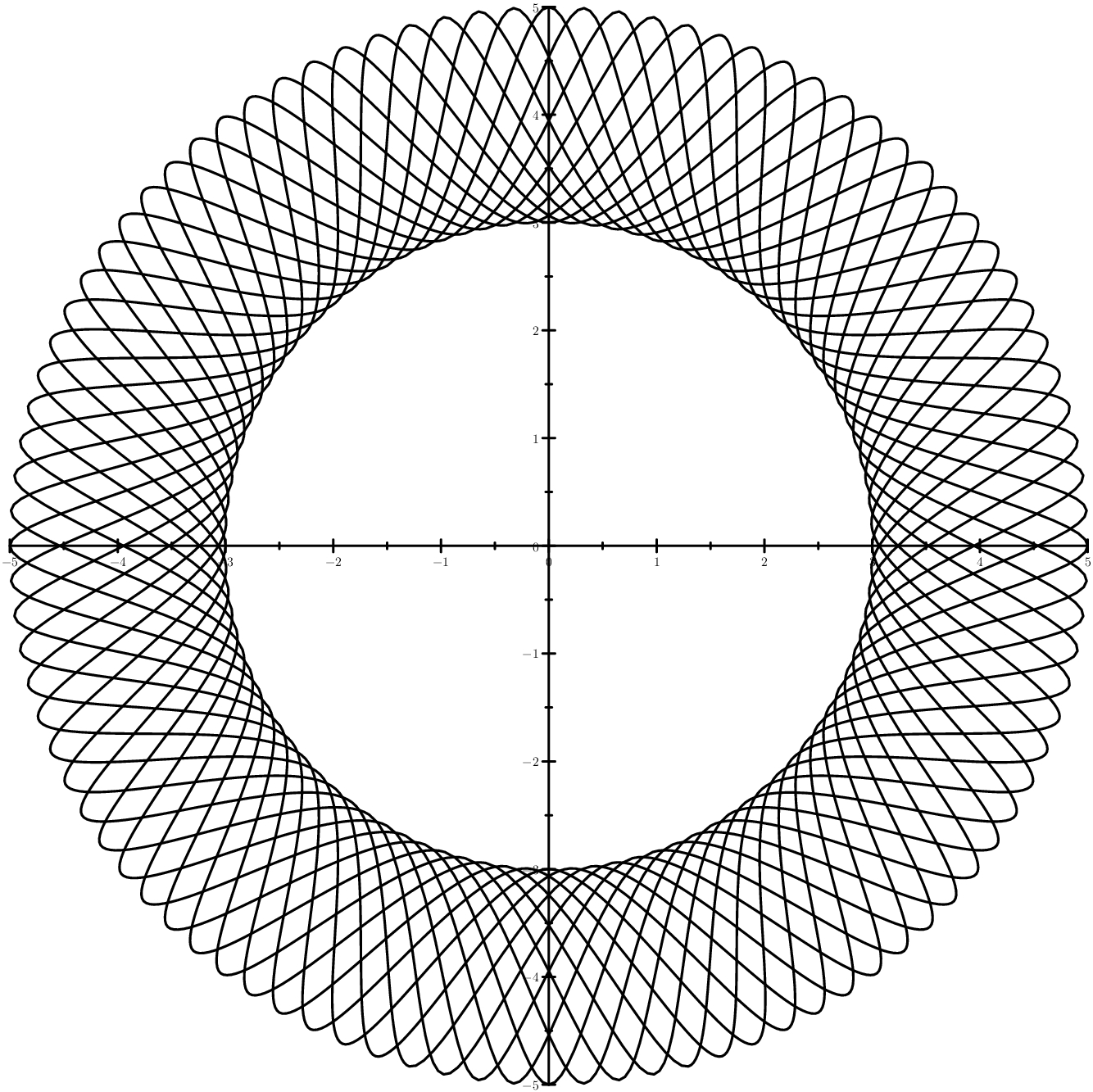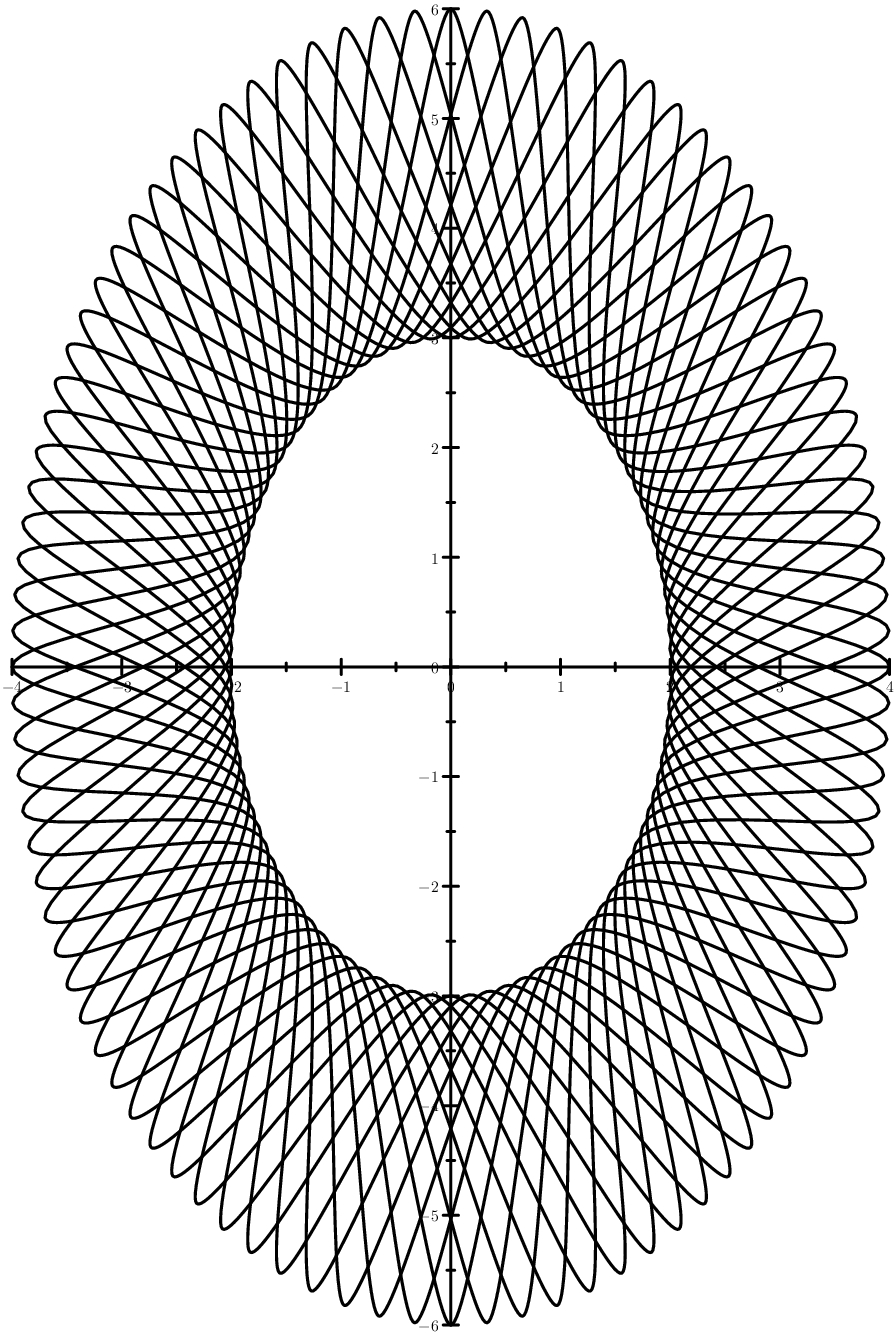扭索状装饰是纸币和其他证券的典型特征。在上一篇文章中可以找到有关它们的详细故事,并涉及历史。那里还给出了一种按点构建断头台的绘图算法。毫无用处,但要注意的是,我们绘制它们不仅是出于娱乐目的,而且出于实用目的,例如,将那些非常有用的东西添加到设计中。成千上万的点只会减慢编辑器的速度,但无论如何它还是无法显示结果-代替真实的连续线条,会得到某种平均点的结果,就像上帝会赋予灵魂一样。因此,现在该考虑另一种算法了-该算法将立即给出向量。由于在流行的曲线编辑器中,仅建议使用贝塞尔曲线进行插值,因此我们将重点介绍它们。实际上,该算法很简单-比第一部分中描述的要简单得多。我们采用两条包络曲线,设置适合360度的波数,估计实际扭索形应从当前点到下一点的角度和曲率,并用四个贝塞尔曲线插值。这是Asymptote中的一个程序,对于此类事情非常方便。import graph;
size(1000,1000);
xaxis(ticks=Ticks);
yaxis(ticks=Ticks);
defaultpen(2);
var zero = (0,0);
real tens(bool at_top, real angle)
{
return angle/180;
}
guide wave(path top, path bottom, int parts, real offset)
{
guide w;
real step = 1/parts;
real half = step/2;
pair[] top_pt;
pair[] bot_pt;
pair[] top_dir;
pair[] bot_dir;
real[] top_angle;
real[] bot_angle;
for(int i: sequence(0,parts-1))
{
real rel = i*step + step*offset;
real top_time = reltime(top, rel);
real bot_time = reltime(bottom, rel+half);
top_pt[i] = point(top, top_time);
bot_pt[i] = point(bottom, bot_time);
top_dir[i] = dir(top, top_time);
bot_dir[i] = dir(bottom, bot_time);
}
for(int i: sequence(0,parts-1))
{
int prev = i == 0 ? parts-1 : i-1;
int next = i == parts-1 ? 0 : i+1;
var v1 = bot_pt[i] - top_pt[i];
var v2 = bot_pt[prev] - top_pt[i];
var a = degrees(v2) - degrees(v1);
top_angle[i] = a<0 ? 360+a : a;
v1 = top_pt[i] - bot_pt[i];
v2 = top_pt[next] - bot_pt[i];
a = degrees(v2) - degrees(v1);
bot_angle[i] = a<0 ? 360+a : a;
}
for(int i: sequence(0,parts-1))
{
int next = i == parts-1 ? 0 : i+1;
var l1 = length(top_pt[i]--bot_pt[i]);
pair ctl1 = top_pt[i] + top_dir[i] * tens(true, top_angle[i]) * l1;
pair ctl2 = bot_pt[i] - bot_dir[i] * tens(false, bot_angle[i]) * l1;
w = w .. top_pt[i] .. controls ctl1 and ctl2 .. bot_pt[i];
var l2 = length(bot_pt[i]--top_pt[next]);
ctl1 = bot_pt[i] + bot_dir[i] * tens(false, bot_angle[i]) * l2;
ctl2 = top_pt[next] - top_dir[next] * tens(true, top_angle[next]) * l2;
w = w .. bot_pt[i] .. controls ctl1 and ctl2 .. top_pt[next];
}
return w;
}
void repeat(int count, path top, path bottom, int parts)
{
real step = 1/count;
for(int i: sequence(0, count-1))
{
draw(wave(top, bottom, parts, step*i));
}
}
path normalize(path p)
{
var min = min(p);
var max = max(p);
var top_center = min + ((max.x-min.x)/2, (max.y-min.y)/2);
return scale(20*1/(max-min).x)*shift(zero - top_center)*p;
}
path top = (338.499521684,-159.274266483)
..controls (327.252951684,-158.148796483) and (323.448961684,-145.618286483) .. (318.743661684,-137.260595483)
..controls (309.897671684,-123.808725483) and (292.025851684,-123.657732483) .. (278.251471684,-118.807470483)
..controls (272.669581684,-117.510629483) and (268.731931684,-109.221757483) .. (274.571781684,-105.645360483)
..controls (281.545351684,-101.031122483) and (290.488261684,-97.7906864833) .. (293.317871684,-89.0437964838)
..controls (296.611021684,-81.8498064838) and (293.894071684,-73.5853264838) .. (295.556161684,-66.3445764838)
..controls (299.563831684,-59.7686064838) and (308.181311684,-64.5344964838) .. (312.903811684,-67.4344264838)
..controls (325.368171684,-74.9872364838) and (341.157891684,-80.6126364838) .. (355.257331684,-73.9383264838)
..controls (363.506651684,-70.9246164838) and (370.115991684,-63.9703964838) .. (378.731941684,-62.0926264838)
..controls (384.688491684,-61.4010364838) and (389.980631684,-67.6129964838) .. (387.306161684,-73.3211464838)
..controls (385.256921684,-82.8346964838) and (388.441441684,-93.9447564833) .. (397.757331684,-98.3016064833)
..controls (403.144721684,-101.085582483) and (412.671611684,-104.606352483) .. (410.331551684,-112.414892483)
..controls (406.654931684,-119.718595483) and (396.921641684,-119.937732483) .. (390.144051684,-122.524267483)
..controls (378.065751684,-125.483516483) and (364.313841684,-130.717262483) .. (359.884541684,-143.562216483)
..controls (356.731021684,-151.157386483) and (350.818391684,-160.192046483) .. (341.435061684,-159.293796483)
..controls (340.456461684,-159.306096483) and (339.478031684,-159.281196483) .. (338.499521684,-159.274296483)
--cycle;
top = normalize(top);
bottom = scale(0.5)*top;
top = ellipse(zero, 4, 6);
bottom = ellipse(zero, 2, 3);
top = circle(zero, 5);
bottom = circle(zero, 3);
repeat(12, top, bottom, 8);
最容易理解的情况是正弦曲线位于两个圆之间。 情况更狡猾-椭圆而不是圆圈。
情况更狡猾-椭圆而不是圆圈。 和接近工业用途的图片:扭索状装饰,形成了一种艺术气息。
和接近工业用途的图片:扭索状装饰,形成了一种艺术气息。 但是,这里的结果并不完美。首先,必须调整tens函数,以使其始终返回0.5的恒定“张力”。其次,曲线不是很对称,在X轴附近的左侧,它们有些混乱。当然,所有这些都可以手动纠正,特别是如果您为国家制造钞票并拥有非常合格的艺术家,但是您可以尝试提高计算的准确性,因为它们显然在信封急剧变化的某些点上误入歧途。由于断头台是插值的,因此出现了一个问题:它们是否与“真实的”(即由点画出的)相吻合?作为微分几何的新手,我很难说,而是“不”而不是“是”。但是谁真正看到了差异?而且不可否认的是,它的实际好处是-拥有数十条Bezier曲线,比起一千个点,它要容易得多,并且它们提供了更多的设计可能性。另外,该算法也可以得到改进。有两种选择可以立即表明自己:a)在外部和内部曲线上指定不同数量的点,然后将不会产生将图案磨得更靠近中心的效果,例如在带有圆形和椭圆形的示例中。b)将点不均匀地放在信封上,例如,使它们更频繁,更不频繁地放置,这将为图案增加新的尺寸。
但是,这里的结果并不完美。首先,必须调整tens函数,以使其始终返回0.5的恒定“张力”。其次,曲线不是很对称,在X轴附近的左侧,它们有些混乱。当然,所有这些都可以手动纠正,特别是如果您为国家制造钞票并拥有非常合格的艺术家,但是您可以尝试提高计算的准确性,因为它们显然在信封急剧变化的某些点上误入歧途。由于断头台是插值的,因此出现了一个问题:它们是否与“真实的”(即由点画出的)相吻合?作为微分几何的新手,我很难说,而是“不”而不是“是”。但是谁真正看到了差异?而且不可否认的是,它的实际好处是-拥有数十条Bezier曲线,比起一千个点,它要容易得多,并且它们提供了更多的设计可能性。另外,该算法也可以得到改进。有两种选择可以立即表明自己:a)在外部和内部曲线上指定不同数量的点,然后将不会产生将图案磨得更靠近中心的效果,例如在带有圆形和椭圆形的示例中。b)将点不均匀地放在信封上,例如,使它们更频繁,更不频繁地放置,这将为图案增加新的尺寸。